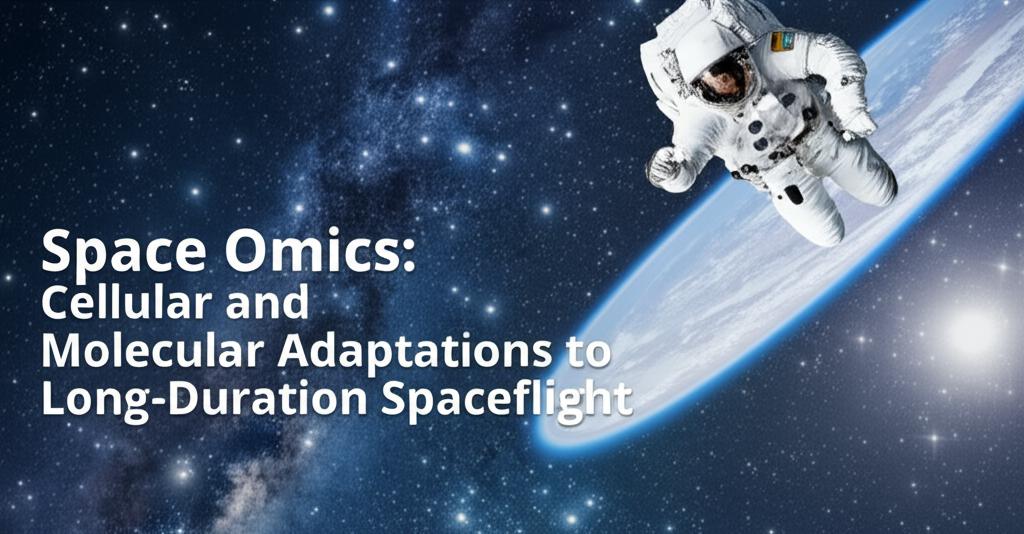Long-duration spaceflight presents a unique and extreme environment for the human body, leading to a wide array of cellular and molecular adaptations. The field of "space omics" utilizes high-throughput technologies – including genomics, transcriptomics, proteomics, metabolomics, and epigenomics – to comprehensively study these biological changes. This research is critical for understanding and mitigating the health risks faced by astronauts on extended missions, such as those planned for the Moon and Mars.
Recent advancements highlight several key areas of impact:
1. Multi-System Physiological and Molecular Shifts:Space travel induces a cascade of changes across multiple biological systems. These shifts are observed at the cellular, molecular, and physiological levels. The Space Omics and Medical Atlas (SOMA) is a significant initiative, creating a database of integrated data and sample repositories from various space missions, including those from SpaceX and NASA. This resource is crucial for biomedical profiling to understand both short-term and long-term health impacts of spaceflight. SOMA includes extensive molecular and physiological profiles covering genomics, epigenomics, transcriptomics, proteomics, metabolomics, and microbiome data. Samples are collected pre-flight, during flight, post-flight, and throughout the recovery period, revealing consistent features across missions as well as mission-specific responses.
2. Mitochondrial Dysfunction as a Central Hub:Comprehensive multi-omics analyses, integrating data from astronauts and ground-based studies (including NASA's GeneLab), have pointed to mitochondrial stress and dysfunction as a consistent and central biological consequence of spaceflight. This involves altered mitochondrial-associated metabolites, changes in nuclear and mitochondrial DNA gene expression related to oxidative phosphorylation (OXPHOS), reduced antioxidant defenses, increased urinary markers of oxidative stress, and altered stress response gene expression. These findings suggest that mitochondrial health is a key area for developing countermeasures.
3. Immune System Dysregulation and Inflammation:Spaceflight is known to affect the immune system. Multi-omics studies, including the NASA Twins Study, have revealed changes in immune function, cytokine shifts, and chronic inflammation. Understanding these molecular changes is vital for predicting and managing immune-related health issues during and after long-duration missions.
4. Musculoskeletal Adaptations:Microgravity exposure leads to well-documented muscle atrophy and bone density loss. "Omics" studies are delving into the molecular mechanisms behind these changes. For example, analyses of astronaut muscle biopsies (m. soleus) before and after spaceflight have shown varying protein expression patterns between short-duration and long-duration missions, suggesting different adaptive responses. These studies also indicate that in-flight exercise countermeasures can have a robust benefit on molecular pathways related to muscle plasticity. Research indicates that space radiation can also negatively impact bone health by increasing the activity of osteoclasts (cells that resorb bone) and decreasing the activity of osteoblasts (cells that form bone).
5. DNA Damage and Repair:The space environment, characterized by increased radiation exposure and microgravity, can induce DNA damage. Studies have shown that microgravity itself might unfavorably affect DNA repair processes. The combined effect of simulated microgravity and radiation has been observed to significantly promote DNA damage markers compared to individual exposures. Research at NASA's Johnson Space Center Radiation Biophysics Laboratory investigates DNA damage and other molecular changes, like transcriptomics, in ISS crew members to better understand these risks.
6. Cardiovascular and Ocular Health:Long-duration spaceflight is associated with risks to cardiovascular health and can lead to Spaceflight Associated Neuro-ocular Syndrome (SANS), which involves vision impairment. "Omics" approaches are being used to understand the molecular underpinnings of these issues, such as vascular remodeling. Metabolomic analyses from the NASA Twins Study identified urinary excretion of certain collagen markers as potential indicators of muscle, tendon, or bone changes.
7. Epigenetic Modifications:Emerging research indicates that spaceflight can induce epigenetic changes, such as alterations in DNA methylation and N6-methyladenosine modification in RNA. These modifications can influence gene expression and contribute to the physiological adaptations observed in astronauts.
8. Advancements in "Omics" Technologies and Data Integration:The field is rapidly advancing due to improvements in next-generation sequencing, mass spectrometry, single-cell analysis, and spatial omics technologies. These tools allow for highly sensitive and precise molecular analyses from often limited biological samples obtained from astronauts. Initiatives like NASA GeneLab provide centralized multi-omics resources and are developing data fabrics to connect datasets with biomedical knowledge graphs, empowering deeper analysis. The development of less-invasive sampling techniques, such as for skeletal muscle and skin, is also a promising area.
Translational Benefits:Beyond astronaut health, space omics research has significant translational potential for medicine on Earth. Insights gained can inform tailored treatments in fields like oncology, cardiology, and age-related diseases. Spaceflight accelerates certain aspects of biological aging, making it a valuable model for studying aging mechanisms and potentially developing anti-aging interventions. Furthermore, understanding immune dysregulation in space could aid in developing therapies for autoimmune diseases and inflammatory disorders on Earth.
Challenges and Future Directions:Despite significant progress, space omics faces challenges, primarily the small sample sizes typical of astronaut studies, which can limit statistical power. Continued international collaboration, the development of robust biobanks like the International Astronaut Biobank associated with SOMA, and sophisticated data analysis techniques are crucial for overcoming these limitations. Future research will focus on refining personalized countermeasures, real-time health monitoring, and further unraveling the complex interplay of molecular changes to ensure the health and safety of astronauts on increasingly ambitious long-duration missions. The integration of multi-omics data will be essential to gain a holistic understanding of how biological systems respond to the unique hazards of spaceflight.

